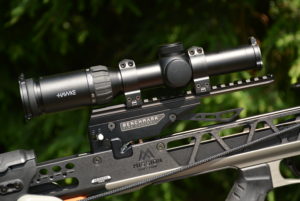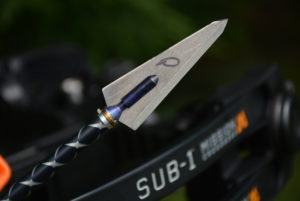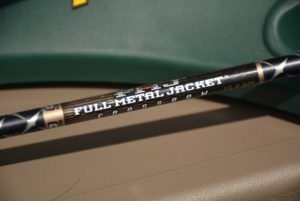With nearly 40 years in archery I’ve battled this dilemma. Is a lighter carbon arrow as effective as a heavier aluminum one? My experience in Africa has proven that a fast carbon arrow, even with a mechanical broadhead, is deadly and has accounted for dozens of animals on multiple safaris.
Recently, I began hunting plains game with a crossbow and pondered the same question? In 2015, my friends and I took 15 animals with 15 carbon arrows and came to the same conclusion. HOWEVER, what about dangerous game? I’m about to launch a Cape buffalo safari and absolutely every source I’ve consulted says that a heavier arrow will penetrate better than a lighter, faster one.
“Mission” Impossible

Archery hunts for black death are dangerous and by law require a minimum of 100 ft-lbs. of kinetic energy. These animals have a nasty disposition and are anatomically armored by nature. Cape buffalo have double, overlapping ribs to protect their vitals that are between its front shoulders, not behind them like North American game. A killing shot must penetrate six inches of shoulder muscle, two sets of ribs, and enter the heart-lung cavity. I learned this the hard way when I shot a 10-year-old bull in the brisket, causing little damage but sufficiently ticking it off. I tracked the animal for four days, yet never got another shot, while the buffalo had ample opportunity to catch and remember my scent. “The wound didn’t look serious,” the Professional Hunter told me. “If another client doesn’t shoot it, come back next year.” (And I am)

Sub 1 Benefits
We used a Mission MXB on the 2015 safari with great results. It performed so well, that I opted for the Sub 1 in 2018 which is 10% faster, clocking right at 350 fps with a 20-inch, 420-grain, carbon arrow and field point. Like earlier MXB models, the Sub 1 does not have a cocking stirrup which makes the bow easier to cock. Because the bow is closer to the ground, a person can use more of their leg muscles. Additionally, the cocking rope sports an orange handle on the right side so that you can quickly cock the bow without getting the hooks upside down. The stock has a technical look with numerous cutouts to reduce weight while maintaining strength. Both the stock butt and the comb are adjustable so that the bow can be tailored to a person’s physical stature.
The bow is topped with a premium Scout scope that clearly labels reticles for accurate shooting. That can be critical at mid-range distances. The labeling eliminates “counting lines” as with some scopes. Upon arrival, the bow shot right to specs, launching at 249.5 fps on the first shot as ready by my new chronograph. Additionally, the stock extended for a more comfortable length-of-pull. Accuracy was exactly as expected.
What About Mass?

Longbow and compound hunters often use arrows that weight 800-1,000 grains for dangerous game, including a heavy broadhead. After some quick experimenting with salt-filled carbon shafts, I realized I could not reach that weight and doubted if I wanted to.
Luckily, I had a new foam target and set out to experiment. I first shot a standard 400-grain crossbow arrow, followed by a salt filled shaft that weighted 750 grains. Did the heavier arrow out penetrate the lighter one? If so, can you guess how much?
Repeated tests from a 330-fps crossbow showed a ½ inch penetration advantage by the heavier arrow over a standard 400 grain arrow. In the months leading to my first Cape buffalo, I lost sleep over the issue. Eventually, I opted for an aluminum shaft inside of a carbon shaft and a 225 grain broadhead. Unfortunately, the heavier weight destroyed the scope reticle markings and I had to guess the drop of the heavy arrow.
Heavy Arrow Try Two
For the 2018 safari, I’m using a 22” Easton FMJ (The heaviest factory shaft I could find) and a 300-grain Steel Force broadhead for a weight of 688 grains. 3-Rivers archery sells a heavy weight test kit with target points weighing 150 to 300 grains in 50-grain increments allowing any archer to test their vertical or horizontal equipment performance with heavier-than-factory shafts.
If you choose to experiment with heavier shafts, scope choice is critical. This year I have Scout’s premium optic that adjusts to arrow speeds from 215 to 450 fps. This excellent scope comes in a 30mm tube for maximum brightness and has illuminated reticles if you want them. I have my Scout adjusted to 270 fps and it shoots accurately with the heavy field points and broadhead.
Final Testing-

“Experts” on arrow penetration say that momentum is more important than kinetic energy which heavily favors speed in its equation. My 270-fps heavy arrow has about the same kinetic energy as a traditional 400-grain set-up. However, the greater mass of the beefed-up arrow results in a 20% increase in momentum. With the buffalo’s life on the line, and perhaps mine, I’m going with the experts.
If you like experimenting with kinetic energy and momentum, Realtree has made it incredibly simple. Visit this website and you’ll have tons of fun:
https://www.realtree.com/kinetic-energy-and-momentum-calculator
Also, the new Sub 1 should see plenty of action in Africa with heavy and standard shafts. Check it out at www.missionarchery.com









![The Best Deer Camp Chili [VIDEO] Deer Chili Ingredients, Tomatoes, Chili Spices](/wp-content/uploads/2015/10/Deer-Chili-Deer-Camp-Recipe-218x150.jpg)








![How to Call Elk Early in the Season [VIDEO]](/wp-content/uploads/2016/08/byers003-218x150.jpg)




![Idiots Disturb Hunter: How Would You Have Handled It? [VIDEO]](/wp-content/uploads/2015/10/DSC00110-e1474487693878-100x70.jpg)
![Albino Buck Shocked to Shed His Antlers [VIDEO]](/wp-content/uploads/2015/10/AlbinoDeer-100x70.jpg)